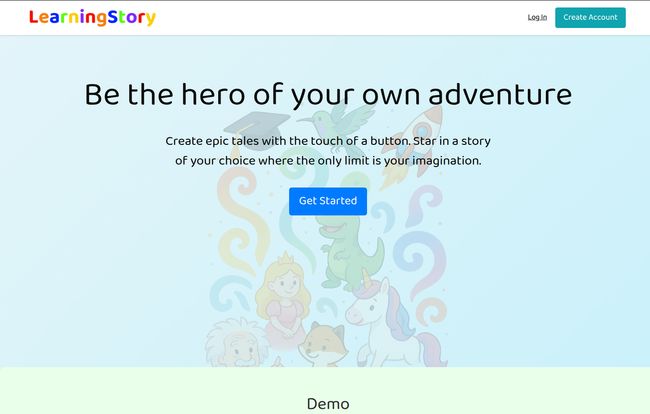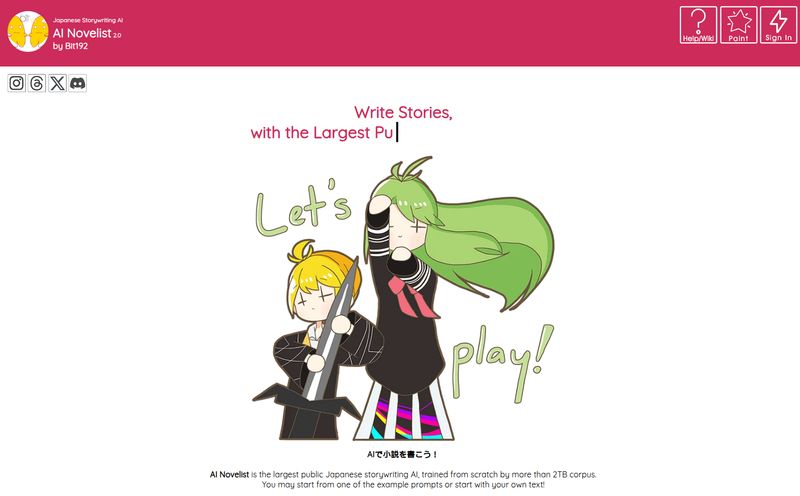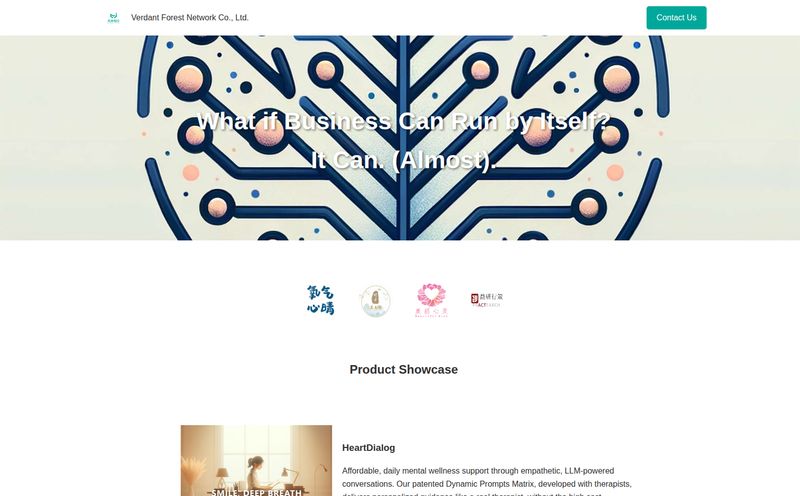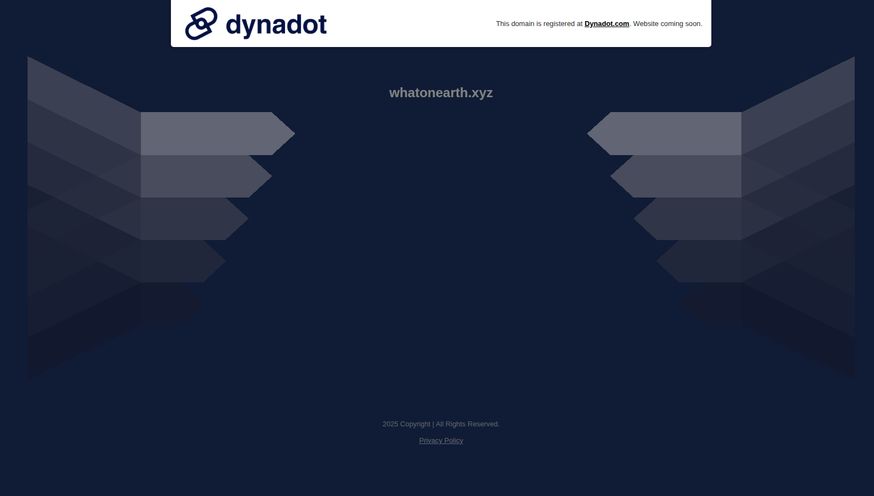I remember being a kid, tucked into bed, waiting for a story. Sometimes it was a classic from a dog-eared book, its spine held together by tape and hope. Other times, my dad would just... make one up. Those were my favorites. Wild, unpredictable tales about talking squirrels who were also secret agents or why the man in the moon was always so sleepy. It was pure magic.
Fast forward a few decades, and the world of storytelling is getting a seriously futuristic upgrade. We've got AI writing marketing copy, creating mind-blowing art, and now, it's coming for the bedtime story. And I have to be honest, as someone who spends their days neck-deep in algorithms and digital trends, I'm both skeptical and incredibly intrigued.
Enter LearningStory. The name alone caught my eye. It’s a platform that claims to create imaginative, AI-powered stories to help your child learn about pretty much any topic. My first thought? “Okay, another AI gimmick.” But the more I looked, the more I felt that old spark of storytelling magic. Could this actually be something special?
First Impressions: What Exactly is LearningStory?
Let's break it down. At its core, LearningStory is wonderfully simple. The website isn't cluttered with a million features or confusing jargon. It gets straight to the point: you tell it your child's name, their age, and a topic you want a story about. Then, you hit a button and—poof—the AI crafts a personalized tale.
Think of it as an imagination engine. You provide the fuel (a kid obsessed with volcanoes and cupcakes, for instance), and it builds the vehicle for a wild adventure. The demo on their site shows a story generated for an eight-year-old named Robbie, resulting in a charming chapter about meeting a friendly Martian. The concept is clean, the execution looks slick, and the potential is... well, it’s huge.

Visit LearningStory
It's this personalization that really sets it apart from just grabbing a book off the shelf. Your child doesn't just read a story; they become the hero of it. That’s a powerful hook for a young mind.
The Magic Behind the Curtain and Why It Matters
So, what’s happening here? This isn’t just a Mad Libs-style fill-in-the-blank. LearningStory uses generative AI to weave a genuinely new narrative based on your prompts. This means you can get incredibly specific. Does your five-year-old need to learn about sharing, but they’re also only interested in pirate ships? Done. A story about Captain Bluebeard learning to share his treasure with his quartermaster, Polly the Parrot.
This approach transforms learning from a passive activity into an active, engaging experience. Suddenly, abstract concepts like kindness, the water cycle, or even basic math problems are framed within a narrative that speaks directly to your child's passions. It’s the difference between reading a textbook and living inside an adventure. And for parents who’ve run out of creative juice after a long day (I see you, I am you), it's like having a Mary Poppins-esque storyteller on call 24/7.
More Than Just a Good Yarn: The Real Benefits for Your Kids
Okay, it’s cool. But does it actually work? The site outlines a handful of benefits, and they align with a lot of what we know about early childhood development. It’s not just about entertainment; it’s about building better brains.
Boosting Brains and Books: Literacy and Cognitive Gains
This is the obvious one. Exposing kids to stories—any stories—is fundamental for literacy. LearningStory takes it up a notch. By creating varied and complex sentences tailored to an age group, it helps build a stronger vocabulary and better comprehension. The site mentions improving spelling and fluency, which makes sense. When a child is invested in a story, they're more motivated to decipher a tricky word or understand a new sentence structure. It also pushes them to think critically. Why did the alien spaceship land? What will Robbie do next? It turns reading into a puzzle to be solved, which is fantastic for developing logic and reasoning skills.
The "Feels" Factor: Emotional and Social Smarts
I think this is the most underrated aspect of the platform. Stories are safe spaces for kids to explore big, complicated emotions. The platform claims its tales help children understand feelings, face challenges, and develop empathy, resilience, and kindness. It’s easy to see how. A story about a nervous little badger on his first day of school can be a powerful tool for a child feeling the exact same way. They see the character overcome their fear and learn that it’s okay to be scared. This kind of emotional modeling is incredibly valuable, and a custom story can hit an emotional target with a precision a generic book just can’t match.
Igniting That Spark: Fostering a Genuine Love for Learning
Let's be real, sometimes getting kids excited about learning feels like trying to push a rope uphill. This is where LearningStory could be a game-changer. By tethering education to pure fun, it helps dismantle the idea that learning is a chore. If your child is fascinated by the deep sea, a story about a brave submarine pilot discovering bioluminescent creatures makes learning about marine biology feel like an epic quest. It nurtures that natural curiosity that all kids have, showing them that the world is full of amazing things to discover.
Let's Get Real: The Potential Downsides and Concerns
Alright, time to put my skeptic hat back on. As promising as this all sounds, we can't ignore the potential pitfalls. No tool is perfect, especially one built on a technology that's still finding its feet.
First, there's the creativity argument. Some might say that relying on an AI to generate stories could stifle a child's—or parent's—own imagination. I see the point, but I disagree with the premise. I don’t see LearningStory as a replacement for imagination, but as a springboard for it. The story it creates can be the start of a conversation, a drawing session, or a whole afternoon of pretend play. It’s a seed, not the whole forest.
Second, and more importantly, is the issue of AI bias and accuracy. AI models are trained on vast amounts of data from the internet, and that data can contain biases and inaccuracies. It's a well-documented problem in the tech world (check out this great piece from MIT Technology Review on the topic). This means a parent can't just blindly trust the output. My advice? Treat it as a collaborative tool. Read the story yourself first, or better yet, read it together with your child. This isn't a 'set it and forget it' babysitter; it's a tool for connection.
Finally, there's the simple fact that it requires an internet connection. Not a huge deal for most, but a bummer for a long car ride through the middle of nowhere or a camping trip.
What's the Price of a Personalized Tale?
This is the million-dollar question, isn't it? As of writing this article, LearningStory's website doesn't have a public pricing page. This is pretty common for new platforms rolling out. They might be in a beta phase, gathering feedback before finalizing their model.
I'd speculate we might see a freemium model—a few free stories per month with a subscription for unlimited access—or a straightforward monthly fee. For now, you'll have to head over to their site and sign up to get the latest details. It seems like you can just get started for free, which is definately the best way to see if it's a good fit for your family.
My Final Verdict: Is LearningStory Worth a Try?
So, where do I land on LearningStory? I’m genuinely optimistic. This feels like more than just a novelty. It's a thoughtful application of AI that addresses a real need: making learning deeply personal and fun for children.
It’s not going to replace the library or the stack of beloved books by your child's bed. And it shouldn't. But as a supplement? As a tool to tackle a specific learning challenge, explore a new interest, or just create a magical moment of connection at the end of the day? I think it’s brilliant. The blend of technology and classic storytelling has the potential to be a powerful new arrow in a parent's quiver.
For any parents or educators out there feeling a little burned out, or for those with a kid who has a very… unique set of interests, I’d say give it a shot. You might just create a story that becomes a new family favorite.
Frequently Asked Questions
- How does LearningStory actually work?
- You provide a few simple inputs: your child's name, their age, and a topic for the story. The platform's AI then uses this information to generate a unique, age-appropriate story from scratch, often starring your child as the main character.
- Is the content from LearningStory safe for kids?
- While the platform is designed for children, the AI-generated nature means parental supervision is always a good idea. It's best to review the story with your child, making it a shared activity and ensuring the content is perfectly suited for them.
- Can LearningStory replace traditional books?
- Not at all! Think of it as a wonderful supplement. Traditional books offer expertly crafted narratives and illustrations that are irreplaceable. LearningStory offers personalization and on-the-spot creativity, making it a different, but equally valuable, tool for fostering a love of reading.
- What age group is LearningStory best for?
- The platform allows you to input your child's age, so it can tailor the story's complexity, themes, and vocabulary. It seems best suited for toddlers through elementary school-aged children who are in the prime of their literacy and emotional development.
- Does LearningStory create pictures for the stories too?
- Based on the demo on their website, it appears that the platform can generate accompanying illustrations for the stories. This adds a fantastic visual element to the personalized tales, making them even more engaging for young readers.
- How much does LearningStory cost?
- Currently, there is no public pricing information on their website. It seems to be free to get started, but they may introduce subscription plans in the future. It's best to visit their official website for the most up-to-date information.
Reference and Sources
- LearningStory Official Website
- MIT Technology Review: This is how AI bias really happens—and why it’s so hard to fix
- Reach Out and Read: The Evidence on the Benefits of Reading



